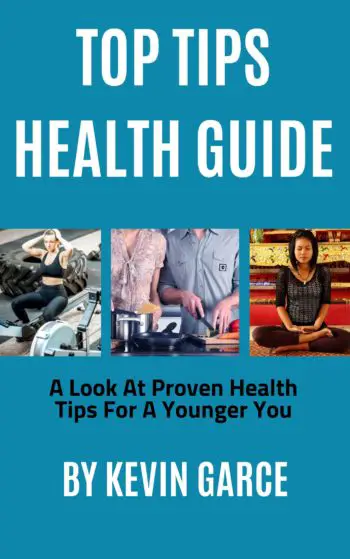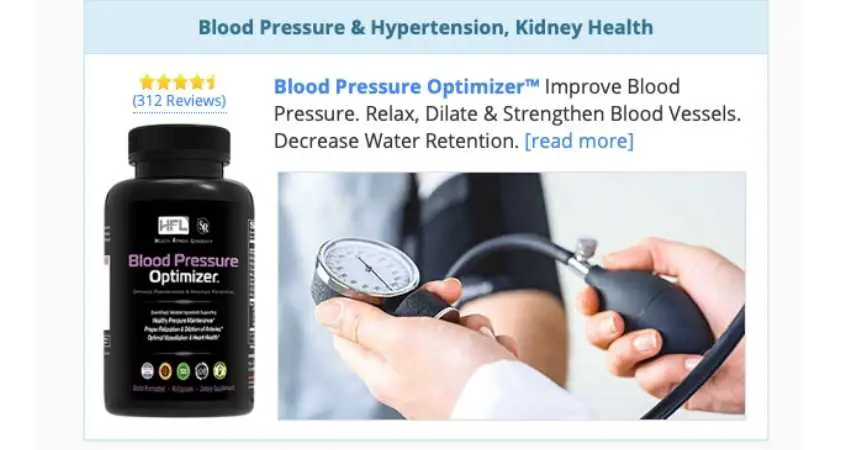Using pressure points is a convenient and effective way to relax. There are a number of pressure points located throughout the body associated with stress relief which can be manipulated by using your fingers. Therefore, what are the pressure points for lowering blood pressure?
9 Pressure points for lowering blood pressure:
- 3rd eye
- Spirit gate
- Pericardium
- Liver 3
- Hand valley
- Back of the neck
- The government vessel
- Thumb nail
- Bright light
This article will explain in detail each of the pressure points listed above. How to apply each one of the pressure points is explained in easy step-by-step instructions. In addition, I’ll explain some of the scientific studies which show how pressure points lowered blood pressure.
BP TIP: Lower BP by just breathing? A device is FDA approved and The American Heart Association gave it the thumbs up. It simply guides your breathing a few minutes a day which is proven to lower BP in studies. You can check it out in the manufacturer’s website by clicking here.
Disclaimer: Some links in this article are affiliate links which means I may earn a small commission at no extra cost to you. As an Amazon associate I earn from qualifying purchases.
Some links in this article are affiliate links which means I may earn a small commission at no extra cost to you. As an Amazon associate and eBay partner, I earn from qualifying purchases.
Pressure Points For Lowering Blood Pressure
1. 3rd Eye Point Pressure Point
This pressure point is called the 3rd eye point and it’s located exactly between the eyebrows, on the curve where the bridge of the nose meets the forehead. It’s known to help people relieve anxiety1.
Here’s how to stimulate the 3rd eye point pressure point:
- It’s easiest to use either your thumb or forefinger and gently press the point for 1 minute.
- While pressing, take long, slow deep breaths to help calm the entire body.
- After 1 minute release, take a brief rest and repeat if necessary until your body feels calm and relaxed.
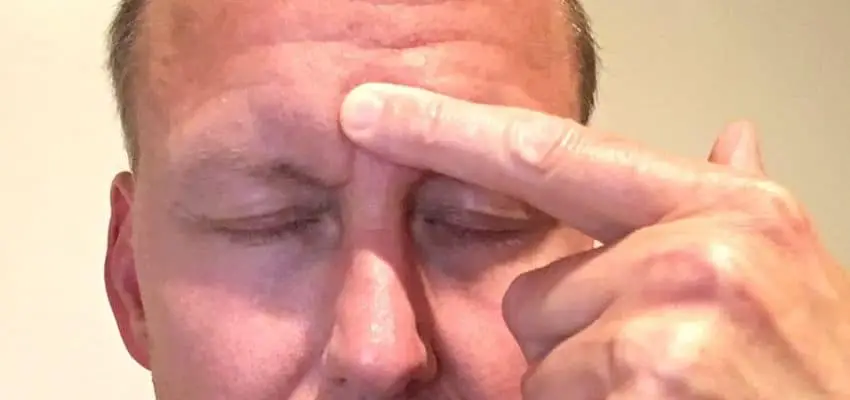
2. Spirit Gate Pressure Point (HT7)
The spirit gate, or HT7, is found on the little-finger side of the inside forearm at the wrist crease2. Pressing this point may help control emotions and promote happiness. Here’s how to stimulate the spirit gate pressure point:
- Activate the pressure point by pressing with the thumb or middle finger of the opposite hand for one minute.
- During the one minute, take long, slow, deep breaths.
- After one minute pause and repeat the activation a second time if needed.
The combination of activating the pressure point and taking deep breaths should help calm the entire body within minutes.
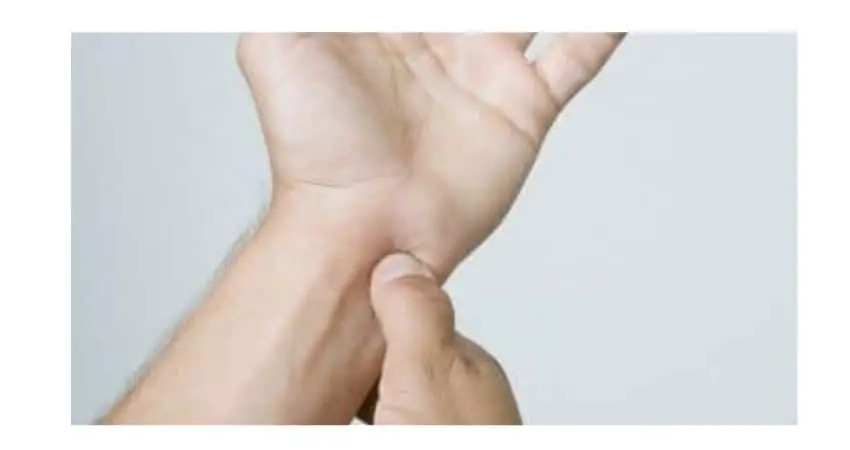
3. Pericardium 6 (P6)
The pericardium 6 is located on the inner side of the forearm, 2 1/2 finger widths down from the wrist crease. This pressure point helps to cure anxiety, nausea and palpitation of the heart3. Here’s how to activate the P6 pressure point:
- The point can be activated on either arm by applying firm pressure for 1 minute to the point using a finger from the other hand.
- While pressing, take long, slow deep breaths to help calm the entire body.
- After one minute pause and repeat the activation a second time if needed.
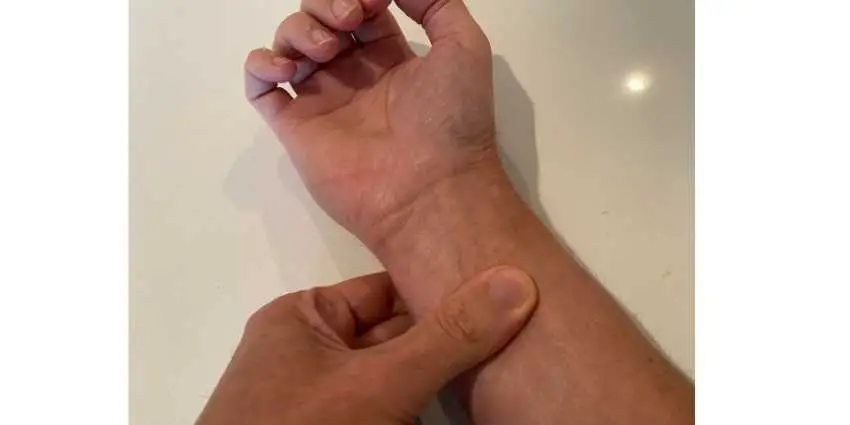
4. Liver 3 or Tai Chong (LV3)
This pressure point, also known as the third liver point, is located on the top of the right foot where the bones of the big toe and the 2nd toe meet each other. On my foot, it’s approximately three inches away from the base of the toes.
It helps to lower blood pressure, anxiety4 and menstrual pains. Here’s how to activate the LV3 pressure point:
- Apply pressure with the thumb for five seconds and then release for one second.
- Repeat this hold and release cycle for 30 times or three minutes.
A second option is to press the point for one minute, rest and repeat as needed. The two steps above are what was performed in the 1st blood pressure study listed below, in the study section of this article.
Pressure points are one of the 35 ways to lower blood pressure in my article, How To Lower Blood Pressure. Check it out and learn more about the other methods including one which lowered systolic 17 mmHG naturally!
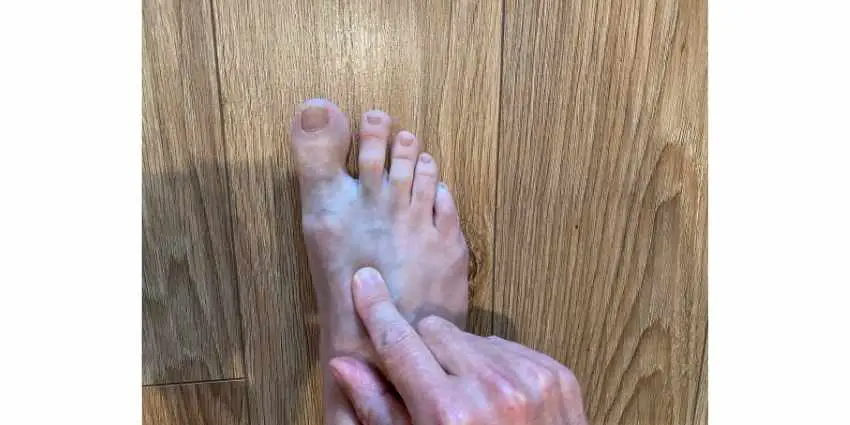
5. Hand Valley Point
This pressure point is located on the top side of the hand, found on the skin between the thumb and index finger. Applying pressure may help reduce stress, headaches, neck and shoulder tension5. Here’s how to activate the hand valley point:
- Using the thumb of the opposite hand, apply pressure for one minute.
- After one minute pause and repeat the activation a second time if needed.
Another option is to gently massage the spot instead of applying steady pressure.
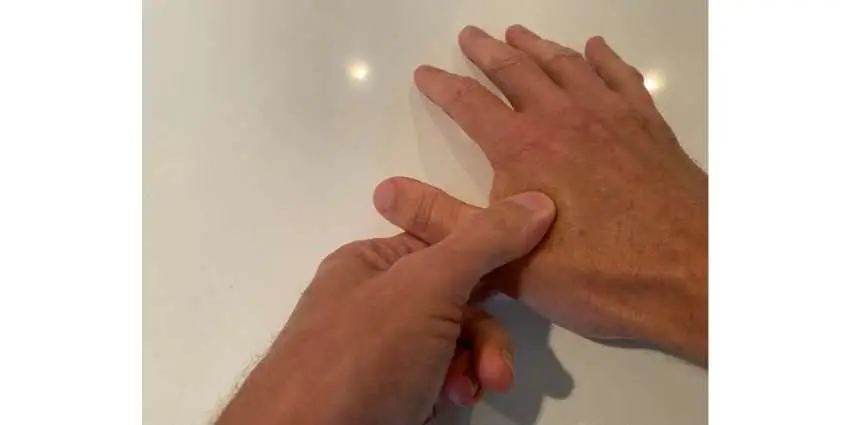
6. Back of the Neck (GB20)
This pressure point is located on the back of the neck, at the base of the skull, on each side of the vertebrae6. It’s actually two points. Applying pressure helps lower blood pressure and improve the gall bladder. Here’s how to activate the GB20 pressure point:
- Place one of the hands at the base of the skull on the back of the neck.
- Apply pressure with the thumb and forefinger on both sides of the vertebrae for one minute.
- Repeat the activation a second time if needed.
Instead of using the thumb and forefinger from the same hand, try using both hands and pressing both points with each thumb.
( Get my free Ebook which includes a breathing technique proven to lower BP 6 mmHg. Click the photo above or here for the free PDF )
7. The Government Vessel (GV20)
This pressure point is located on the top of the skull7. If an imaginary line is drawn from ear to ear across the top of the head, you’ll find the GV20 at the top. Here’s how to activate the GV20 pressure point:
- Press the top of the head with the middle three fingers for one minute.
- Repeat the activation a second time if needed.
Another option is to massage the pressure point instead of applying pressure with the fingers.
Breathing exercises are another natural way to lower blood pressure and is easy to perform at home. Check out my article on the topic with nine breathings exercises you can start doing right now, Breathing Exercises To Lower Blood Pressure Naturally.
8. Thumb Nail Point
This pressure point is located on either thumb nail. On the right hand, it is located on the lower left corner of the nail. On the left hand, it is located on the lower right corner of the nail. The thumb nail point helps to relieve negative emotions.
Here’s how to activate the thumb nail point:
- Using the thumb of the opposite hand, apply pressure for one minute.
- Relax and repeat up to three times if needed.
9. Bright Light Pressure Point
The bright light pressure point is located on either side of the bridge of the nose below the tip of each eyebrow. It helps to relieve tension around the eyes, particularly produced from staring at computers.
Here’s how to activate the bright light pressure point:
- Apply pressure to both points with the thumb and forefinger of one hand for one minute and release.
- Repeat as needed or up to three minutes.
How Pressure Points Can Lower Blood Pressure
It seems difficult to believe performing an easy and fast method like activating a pressure point can be beneficial for lowering blood pressure. For this reason, many people ask, can pressure points lower blood pressure?
Pressure points can lower blood pressure by stimulating the nerves, connective tissues and tiny muscles in parts of the body. The stimulation relaxes the body and mind which lowers stress and stress hormones. Relaxation and low stress are proven to lower blood pressure.
Some of the pressure points, like the ones in this article, are associated with stress relief ((National Center for Biotechnology Information: Chapter 5 Clinical effectiveness: acupressure, acupuncture and nerve stimulation)). Stress relief is an effective way to lower blood pressure and keep the stress hormones low.
The following are studies showing how pressure points lowered blood pressure.
Study
A study published in 2016, involved 80 patients with high blood pressure. During the study pressure was applied to the Taichong acupoint.
This pressure point is located on the top of the right foot where the bones of the big toe and the 2nd toe next to it meet each other. On my foot, it’s approximately three inches away from the base of the toes.
Pressure was applied for five seconds and then released for one second. This hold and release pattern was repeated 30 times for three minutes. On the control group, pressure was applied to a fake pressure point one inch over to the side.
Both groups had their blood pressure measured before the pressure point activation, immediately after, 15 minutes after and then 30 minutes after. The table below shows the results of both groups.
| Variables | Experiment Group (Taichong Pressure Point) | Control Group (Fake Pressure Point) |
| BP before pressure point | 165.0/96.3 | 154.8/94.3 |
| BP Immediately after pressure point | 150.4/92.7 | 153.7/93.3 |
| BP 15 minutes after pressure point | 145.7/90.8 | 154.8/93.2 |
| BP 30 minutes after pressure point | 142.9/88.6 | 155.7/94.1 |
As you can see in the table, BP dropped drastically for the group who received pressure on the real point while the control group’s BP remained almost the same. The participants in the experiment group experienced a reduction in both systolic and diastolic blood pressure immediately8.
The experiment groups BP continued to drop 15 and 30 minutes after the pressure point was activated. Previous studies have shown blood pressure reductions as long as 2 1/2 hours after the pressure point activation was completed9.
( BP Optimizer – Lower BP Naturally, In Only 30 Days Or Pay Nothing…Visit Website Here )
Study
An older study involved 67 people with high blood pressure and was published in the Journal of Traditional Chinese Medicine. The Taichong pressure point was activated once a day for seven straight days.
The participants blood pressure was checked once before and 30 minutes after. Both systolic and diastolic blood pressure was significantly lowered after the seven days. The study noted, after one day the decrease in blood pressure was obvious10.
Study
In this study 160 people with high blood pressure were given six weeks of pressure point activation. In total, the treatment included 22 sessions of 30 minutes each. Blood pressure was measured before the sessions, after the six weeks and then three and six months later.
After treatment, blood pressure reduced significantly. Systolic decreased 5.4 mmHg and diastolic 3.0 mmHg. At three and six months, the patient’s blood pressure levels returned to the pretreatment levels11.
Wrapping Up The Pressure Points For Lowering BP
Utilizing pressure points isn’t a field of medicine and is not meant to replace medication or any treatment recommended by a physician.
Activating pressure points falls under the disciplines of acupressure and reflexology. According to those who practice, applying pressure to certain points on the body can restore health, energize and relax the body or other body parts12.
Experts say applying pressure to points isn’t likely to have adverse effects on the body. Applying pressure to pressure points is noninvasive and typically safe to practice. Always consult with your physician prior to conducting any form of exercise or treatment.
Read Next – More BP Lowering Articles!
Can Breathing Exercises Lower Blood Pressure?
11 Easy Exercises To Lower Blood Pressure
Does Green Tea Lower Blood Pressure?
25 Ways To Lower Blood Pressure Naturally
- National Center for Biotechnology Information: Acupuncture or Acupressure on Yintang (EX-HN 3) for Anxiety: A Preliminary Review [↩]
- National Center for Biotechnology Information: Clinical application of single Acupoint (HT7) [↩]
- National Center for Biotechnology Information: Neural specificity of acupuncture stimulation at pericardium 6: evidence from an FMRI study [↩]
- National Center for Biotechnology Information: The effect of acupressure at third liver point on the anxiety level in patients with primary dysmenorrhea [↩]
- National Center for Biotechnology Information: Contemporary acupressure therapy: Adroit cure for painless recovery of therapeutic ailments [↩]
- World Scientific: Effect of Acupressure and Trigger Points in Treating Headache: A Randomized Controlled Trial [↩]
- National Center for Biotechnology Information: Locating the Acupoint Baihui (GV20) Beneath the Cerebral Cortex with MRI Reconstructed 3D Neuroimages [↩]
- National Center for Biotechnology Information: Effectiveness of Acupressure on the Taichong Acupoint in Lowering Blood Pressure in Patients with Hypertension: A Randomized Clinical Trial [↩]
- National Center for Biotechnology Information: [Effect of needling quchi and taichong points on blood levels of endothelin and angiotension converting enzyme in patients with hypertension] [↩]
- Semantic Scholar: The Immediate Effect on Blood Pressure of Acupuncture at Taichong (LR 3) in 65 Cases of Hypertension Patient with Hyperactivity of Liver-yang [↩]
- Circulation: Randomized Trial of Acupuncture to Lower Blood Pressure [↩]
- National Center for Biotechnology Information: Revisiting reflexology: Concept, evidence, current practice, and practitioner training [↩]

